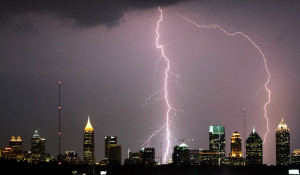Lightning Facts and Fallacies
The next time you see or hear a thunderstorm in Buffalo, you might want to take a moment to review what you know about lightning safety. Strikes are most common during the summer thunderstorm season, but they can happen at any time of the year. And, a lot of less-than-accurate ideas about lightning have found a place in the popular imagination over the years. Here’s a look at current knowledge.
Indoor Safety
The safest place to be during a storm is typically indoors, but it is important to avoid anything that conducts electricity – metal, landline phones, appliances, wires, TV cables and plumbing.
Automobiles can be safe havens thanks to the metal frame that diverts the electrical charge. Don’t lean on the doors during a storm, though.
Outdoor Safety
Don’t look for shelter under a tree. If lightning hits its branches, a “ground charge” could spread out in all directions.
Don’t lie flat on the ground. This makes you even more vulnerable to a ground charge.
Don’t crouch down. Once recommended, the “lightning crouch” has been discredited – it’s not likely any safer than standing if you’re outside during a storm. Instead, get inside or into a car.
Where Strikes Will Happen
Contrary to folk wisdom, lightning does indeed strike twice in the same place. The best example is New York City’s Empire State Building. It was once a lightning laboratory due to being struck scores of times every year.
Lightning doesn’t only strike the tallest objects. Although tall, pointy, isolated objects are often hit, lightning has been known to hit the ground instead of buildings and parking lots instead of telephone poles.
The presence of metal doesn’t affect where and if lightning will strike. Neither mountains nor trees contain metal, and both get struck. However, metal is a conductor of electricity, so avoid it during any storm.
Strikes don’t just happen in areas where rain is falling. Even if you’re miles away from a thunderstorm, lightning can still occur.
Finally, it’s important to remember that you won’t be electrocuted if you touch someone who has been struck – the human body doesn’t store electricity. So, by all means, give a lightning strike victim first aid. You might just save a life.


